Very good, I have no idea of the experimental 57 mm gun, look rather similar to the british 6 pounder.
Very good info Tom…
Hi.
Type 4 70 mm rocket launcher:
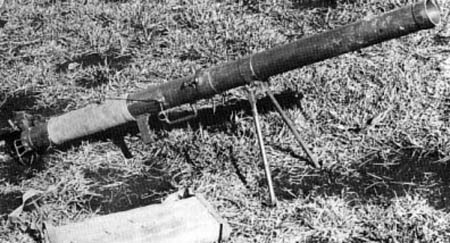
In early 1943 the japanese Army was able to capture some US 60 mm Bazookas. As these weapons were extremely light and had a larger penetration ability than most japanese at-guns the decision was made to develop a similar weapon.
In late 1943 design data of the german Raketenpanzerbüchse 54 were delivered to Japan speeding up the own development. In early 1944 the 70 mm rocket launcher (exact caliber 72 mm) was tested at the Osaka Army Arsenal.
To minimize the transport size the launcher could be disassembled into two parts. The firing mechanism was copied from the US Bazooka. A bipod could be attached to the 1500 mm long barrel. Total weight was 8 kg.
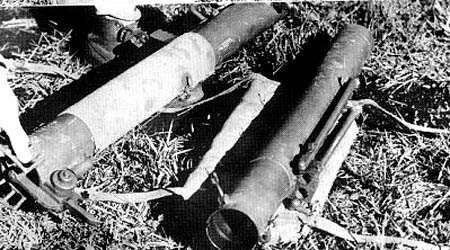
The rocket propelled grenade had a total length of 359 mm and was projectile-shaped with small fins giving a rotation to stabilize the flight. Muzzle velocity was 160 m/s with a propellant weight of 260 g and a burntime of 0,4 sec.
Minimum range was 50 m to arm the fuze which was armed after few rotations. The maximum range was 800 m, maximum effective range 100m with a hit accuracy of 60%. The penetration ability of the hollow-charge warheads with an explosive weight of 700g was 80 mm. The inmpact fuze only worked in hit angles between 90° and 60°. Below 60° the warhead didn´t detonate.

The two-men-crew consists of gunner and loader. An experienced crew could reach a rof of 6 rpm. A total of 3300 type 4 rocket launchers were produced at Ogura and Osaka Army Arsenals from July, 1944. All were given to units preparing for the homeland defence, non were used outside Japan.
experimental 90 mm rocket launcher:

As the penetration ability of 80 mm was found too weak in early 1944 an enlarged version was ordered. In late 1944 a test version with a barrel length of 1500 mm was produced and tested. A third leg was attached behind the trigger element to increase stability during firing. With a total weight of 12 kg a 8,6 kg rocket propelled grenade could be fired. With a propellant weight of 620 g, giving a muzzle velocity of 106 m/s, the warhead, filled with 1,6 kg explosive, was able to penetrate 120 mm on 100 m. A short version with a 1200 mm long barrel was developed for the airbourne units. There is no report of a serial production.
Yours
tom!
Hi.
type 5 (experimental) 45 mm recoilless rifle:
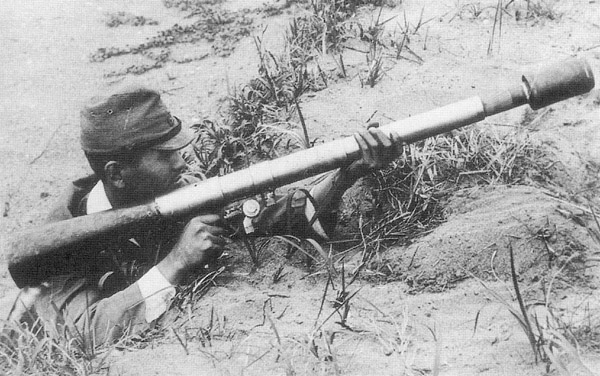
In late 1944 the decision was made to develop a short-range infantry anti-tank weapon based on the german Panzerfaust but reloadable. This weapon should be light with a hollow-charge warhead giving a minimum penetration of 120 mm.
In 1945 three test versions with different position of the firing mechanism and different barrel diameter were built. All had a conical extension with a length of 380 mm at the rear end to minimize the recoil. All used an experimental grenade with a length of 800 mm, 2,3 kg weight, propellant charge of 35 g and an explosive weight of 500g.

Version 1 had a barrel length of 600 mm and. With a barrel diameter of 45 mm the maximum penetration was 100 mm.
Version 2 had a barrel length of 1000 mm. With a diameter of 57 mm the maximum penetration was 110 mm.
Version 3 had a barrel length of 1000 mm. With a diameter of 45 mm the maximum penetration was 110 mm.
The decision was made to continue development of version 3. The final version had a weight of 6,4 kg, a barrel lenght of 1000 mm and the 380 mm long conical rear extension.

Different types of rocket propelled grenades were tested with propellant charges of between 30 g and 100 g. The explosive weight was increased to 625 g, the total weight was still 2,3 kg.
The final version had total lenght of 850 mm with a propellant part of 180 mm length, a propellant weight of 100 g, a 520 mm guidance stick with an impact fuze on top and a warheas of 150 mm with an explosive weight of 625 g. Muzzle velocity was 40 m/sec., minimum range 50 m, maximum range 150 m, penetration 120 mm.

Yours
tom!
Beatiful.
Checking the last picture of the hollow charge grenade I think the japs should give more lenght between the end of the copper cone and the grenade head, the hollow charge need more espace between the charge and the armor to made the best use of the fire jet.
Hi.
experimental tank hunter studies:
As effective at-guns would be too heavy to be used with the standard infantry doctrine some designs were started to increase mobility of larger caliber guns.
light anti-tank gun carrier So-To:

1939 gun carrier study bassed on the type 95 light tank Ha-Go. The gun could be attached on top of the closed fighting compartment. The carrier was planned for the type 94 37 mm infantry gun/type 1 37 mm at-gun and the type 1 47 mm at-gun
47 mm tank hunter study:

A tank hunter based on the type 94 tk special tractor with gun firing to the back. The fighting compartment is open to the top and back.
type 5 experimental 47 mm tank hunter Ho-Ru
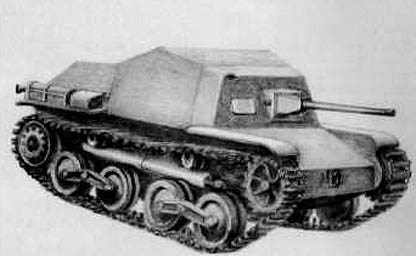
Experimental tank design based on the type 3 light tank Ke-Ri with closed fighting compartment similar to the german Sturmgeschütze. The design was abandonned just before the prototype production should be started as the 47 mm at-gun was found too weak and the type 5 75 mm tank hunter Na-To became ready for serial production.
Yours
tom! 
Hi.
Type 5 tank hunter Na-To:
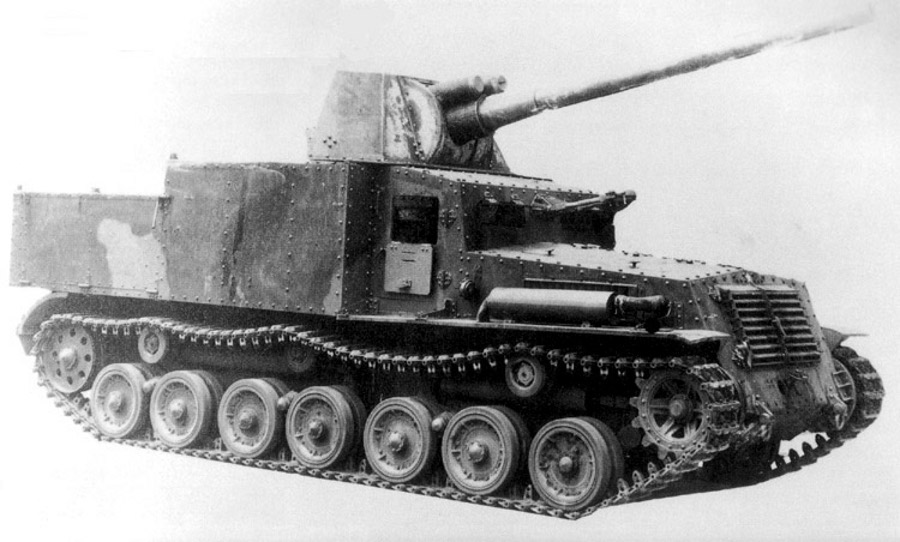
In 1943 the decision was made to develop a tank gun based on the type 4 75 mm aa-gun which became operational in early 1944.
For this gun a special gun carrier should also be developed, based on the chassis of a newly designed full-tracked heavy transport vehicle using a remodelled chassis of the type 4 experimental tank Chi-To.
A prototype was built in April, 1944. The engine of this vehicle was placed in the bow. The engine room and the driver cabin for the driver and the wireless operator were armoured with welded 12 mm thick armour plates.
Behind the driver´s cabin the type 4 75 mm tank gun should be placed on a special pivot mount. A 12 mm gun shield should covered the 5-men gun crew from infantry ap-rounds, but only from the front. The chassis was tested in summer 1944 showing a large vulnerability of the gun crew regarding infantry fire from the sides. This was solved by installing two aditional side armour plates on both sides of the gun mount.
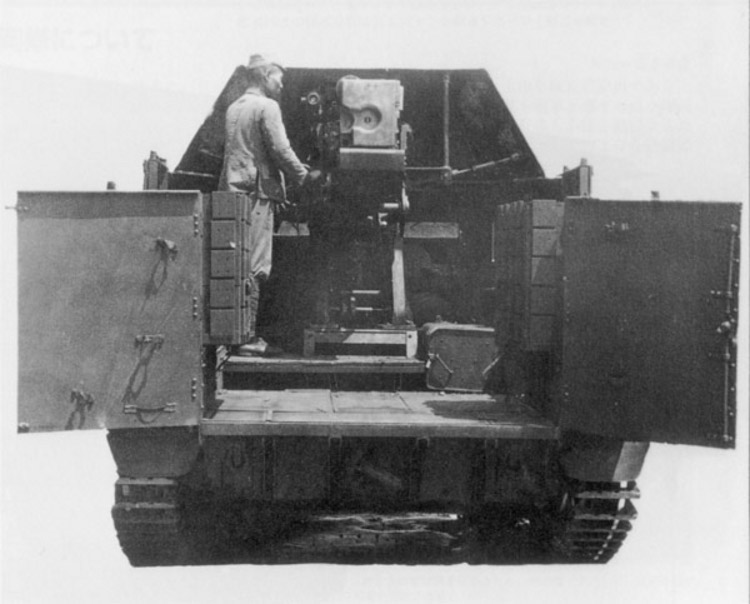
The gun prototype was also tested in Summer 1944 showing multiple problems with stability and recoil mechanism making a major redesign necessary. This redesign was done in early 1945. Now there were additional problems with the gun mounts of the type 4 tanks but as the guns on the Na-To were mounted on a pivot there was no problem for the use on the tank hunter.
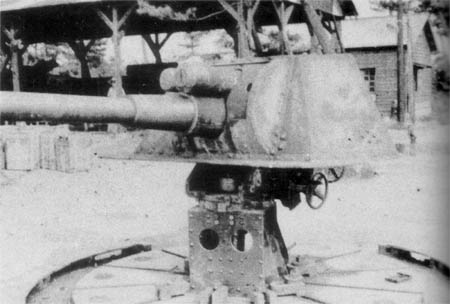
The completed vehicles were tested in spring 1945 showing a good mobility and cross-county ability. The gun was able to penetrate the US medium M4 on ranges over 1000 m making the vehicle a dangerous weapon. In May, 1945, a couple of type 5 75 mm tank hunter Na-To were sent to northern China for battlefield tests. It is possible that these vehicles were destroyed during the soviet attack in August, 1945 but all documents egarding these late-war developments were destroyed after the japanese surrender.
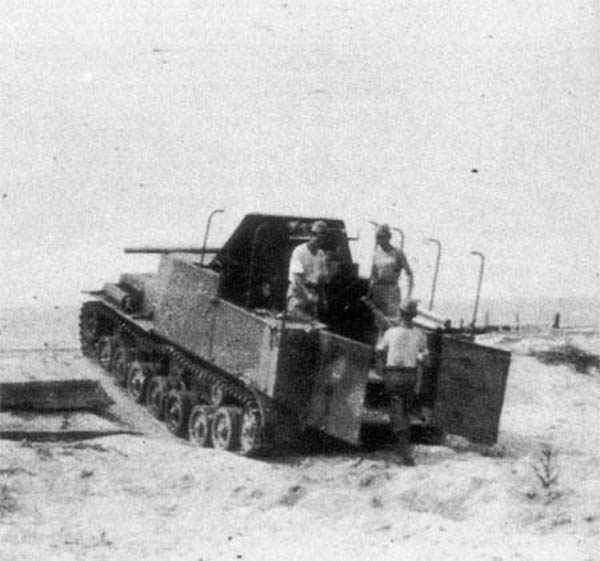
data:
manufacturer: Osaka Rikugun Zoheisho (Osaka Army Arsenal)
number of vehicles built: total number unknown, but > 10
total weight: 15 t
crew: 7 men
maximum armour strength: 12 mm
length: 5800 mm
width: 2400 mm
height: 2750 mm
engine: Mitsubishi 8 cylinder gasoline engine
power: 165 hp bei 2000 rpm
maximum speed: 40 km/h
power-weight-ratio: 11 hp/t
armament: 1 X Typ 5 75 mm gun
Yours
tom!
Hi.
Now the real heavy things:
Part 1:
From early 1943 a heavy 105 mm tank gun was developed based on an experimental 105 mm heavy artillery gun, a remodelled type 92 105 mm gun. The development was made quickly and with only few problems to solve the design was tested in spring 1944. The tests were done successfully and so in summer 1944 a 105 mm tank gun was ready for service but there was no idea how to use this gun. Due to the weight of more than 5 t and a total length of more than 7 m no actual tank or tank design was able to carry this gun.
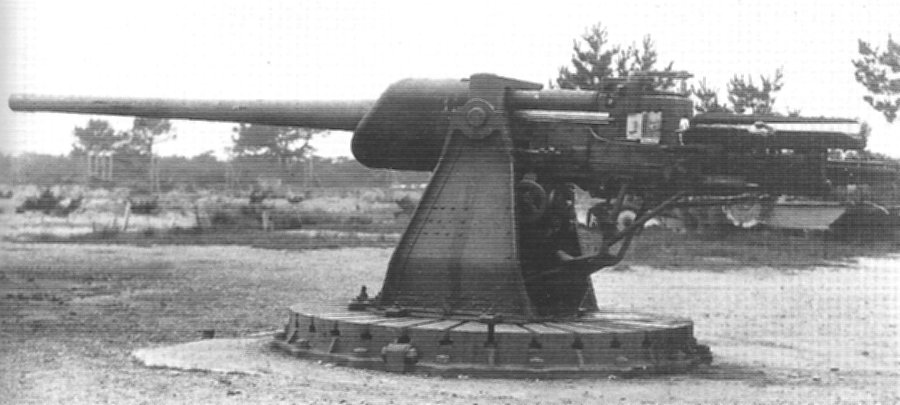
data:
caliber: 104,9 mm
barrel length: 4720 mm
muzzle velocity: 900 m/sec
grooves: 32
spin direction: right
ammunition:
projectile: 16 kg
propellant charge: 30 kg
penetration: 150 mm/90° on 1000 m

gun immediately after firing
This lead to a redesign of the turret planned for the super-heavy tank project named O-I. Additionally studies were started to develop a turret for the planned type 5 tank Chi-Ri. Due to a massive lack of resources none of these projects could be finished until mid 1945 and so an interim solution was designed, the
experimental 105 mm tank hunter Ka-To:

This vehicle was based on the design of the type 5 experimental tank Chi-Ri. The planned total weight was about 30 t. The superstructure was similar to the one from the Na-to but had a maximum armour strength of 25 mm. The wireless operator was removed making a smaler driver´s cabin possible. This should give the Ka-To a maximum traverse of + - 45°. The gun was mounted on a pivot lafette and equipped with an armoured housing, only open to the back. Frontal armour was 25 mm, side armour 20 mm, top armour 12 mm.

At the end of the war the design was almost ready for the prototype stage. Most detail documents were destroyed.
planned data:
total weight: 30 t
crew: 6 men
maximum armour strength: 25 mm
length: 7390 mm
width: 2850 mm
height: 2850 mm
engine: Mitsubishi Diesel engine
power: 400 hp
maximum speed: 40 km/h
armament: 1 X Typ 5 105 mm tank gun
Yours
tom!
Hi.
Part 2:
Heavy tank destroyer Ho-Ri:
The japanese Army payed a lot attention on the german heavy Panzerjäger like Ferdinand/Elefant, Jagdpanther and also Jagdtiger. Having a gun with a penetration ability like the german 8,8 cm Pak 43/3 and a chassis for tank weights of up to 45 t the decission was made to build a similar tank destroyer. The design started after the chassis of the type 5 experimental tank Chi-Ri became ready for service in early 1945. In the first stage two different designs were made:
Ho-Ri I:
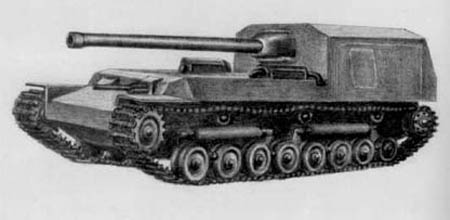
Using chassis and superstructure of the type 5 tank the engine should be placed in the middle of the vehicle. The gun should be placed in a heavily armoured casemate in the back of the vehicle. The planned armour thickness of the casemate was 150 mm frontal and 100 mm on the sides and back.
For close defence the standard bow armament of the type 5 tank should be used, a type 1 37 mm tank gun with a coaxial type 97 7,7 mm tank machine gun. Additionally machine gun mounts in the sides and the back of the casemate were planned.
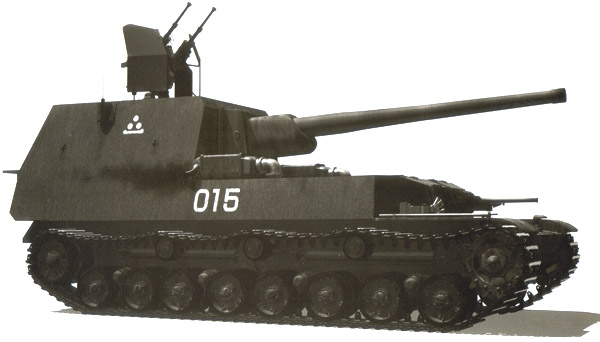
Ho-Ri II
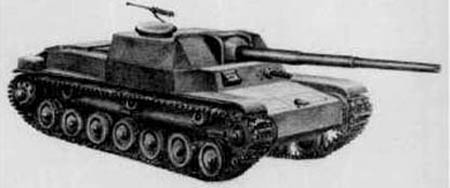
Also using chassis and superstructure of the type 5 tank the tank gun should be placed in a casemate installed instead of the tank turret. Armour strenth of the casemate should be the ame as on the Ho-Ri I. For close defence a machine gun should be mounted in the bow and a type 98 2 0 mm aa-machine gun should be mounted next to the commanders cupola. Some changes were made just before the designs should be presented to the Army High Command. The casemate had been simplified for faster building and the type 1 37 mm tank gun was added to the bow machine gun again. On the other hand the aa-machine gun was removed and additional machine gun mounts were added.
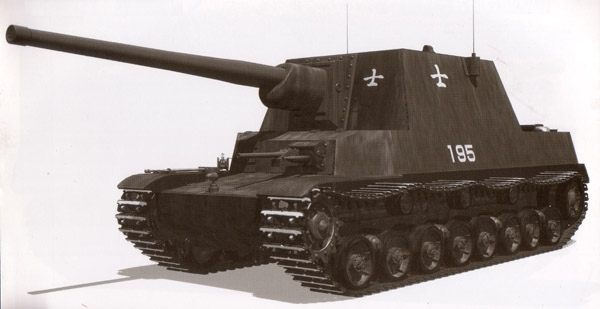
The Army decided to develop the Ho-Ri I design and a type 4 20 mm aa-gun twin mount was added to the casemate top. Until surrender only early development stages were finished. Prototype manufacturing was planned for December, 1945.
planned data:
total weight: 40 t
crew: 6 men
maximum armour strength: 150 mm
length: 7400 mm
width: 3050 mm
height: 2700 mm
engine: licence built BMW 12-cylinder gasoline aircraft engine
power: 550 hp
maximum speed: 40 km/h
armament:
1 X Typ 5 105 mm tank gun (60 rounds)
1 X type 1 37 mm tank gun (100 rounds)
1 X type 4 20 mm twin aa-machine-gun (480 rounds)
2 X type 97 7,7 mm machine gun (4980 rounds)
Yours
tom!
Hi.
Type 93 multi-purpose mine:
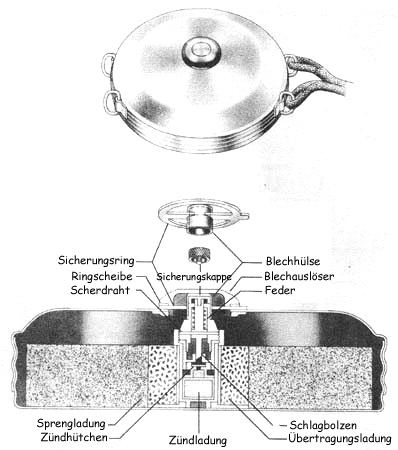
From top left:
- safety washer
- brass cap
- washer
- safety cap
- brass dome
- shear wire
- spring
- main filling
- striker
- percussion cap
- detonator
- booster
Data:
diameter: 171,5 mm
over-all height: 44,5 mm
weight: 1360 g
explosive weight: 900 g
type of explosive: Picric Acid
Description:
The mine is circular with a slightly domed top and flat bottom. It is constructed of an upper and lower section of sheet metal secured together by four heavy corrugatuions in the walls which serve as threads. The overlap of the walls of the two sections is sealed with a bituninous paint. The interiour of the container is painted with a black enamel to secure the metal from the corrosive effects of the Picric Acid. The explosive is inserted as solid ring main charge of cast Picric Acid with an inner booster of pressed powdered Picric Acid containing a 16 mm diameter central hole to house the fuze. The explosive is completely covered by a layer of paper, shellacked to the explosive and waxed externally.
Soldered on the inside of the lower mine section is a brass disc, 39,7 mm in diameter, having a threaded collar for the insertion of the fuze.
The central hole in the upper section is reinforces with a brass collar threaded to receive the brass plug. A thin leather washer fits between the brass plug and the collar to seal the mine.
Two brass rings are fastened to two opposite sides of the upper section by means of a soldered metal strip. Drag ropes may be fastened to the rings.
The fuze assemby consists of a striker held under spring pressure by a shear wire, a percussion cap, a primary detonator, and a larger secondary detonator all incorporated in the fuze body which is threaded on the lower end to srew into the collar in the bottom of the mine. A safety cap is screwed into the upper end of the striker until the mine is laid. An additional safety feature is a brass cylinder with attached washer which fits over the brass safety cap and rests on top of the fuze body, the washer fitting under the leather washer of the brass plug.
The mine is painted olive-drab with a narrow red ring around the brass plug.
Employment:
Antipersonnel and antitank
The Japanese have two sizes of shear wire for this mine. One for antipersonnel use shears at 32 kg, the other, for antitank use shears at 1135 kg. These mines have been found burried upside down with additional explosives placed beneath them to increase their effect. The A/P fuze has a black upper body
Operation:
With the safety devices removed any load on the cover of the mine causes the brass plug to press down the striker. If the prssure is sufficient, the shear pin is sheared. This frees the striker which, under pressure of the spring, strikes the percussion cap initiating the detonating system.
provisional Panzerfaust:
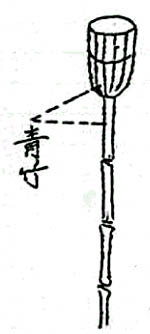
In 1944 investigations were made by the Army Headquater if a serial production of the german Panzerfaust 100 is possible. Due to the lack of raw materials and industrial ressources a production seemed impossible.
In early1945 guidelines for the defence departments of all prefectures were published how to built weapons for militia units using natural materials. Under these guidelines was one concerning the development and production of Panzerfaust-type at-weapons.
for the barrel bamboo should be used. The inner walls should be drilled out, in order to receive a continuous pipe of about 950 mm. A basket made of bamboo fibers installed at the front end should increase accuracy.
The grenade should be made of a bamboo shaft with a diameter, which had to fit into the bamboo launcher tube, and an up to 300 mm long hollow-charge warhead made of wood or sheet metal usind a steel or copper cone. The propellant charge should have a weight of between 30 and 40 g, the weight of the explosive filling should not exceed 1 kg.
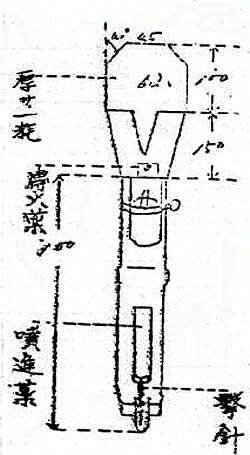
A penetration of 100 mm should be reached in trials. The weapons should be manufactured by local factories and craftsmen.
I do´t know if there was any serial production.
Yours
tom!
Hi.
Type 3 multi-purpose mine:
type 3 mark a:

from top left:
- safety pin
- hammer release fork
- cover
- hammer spring
- striker
- percussion hammer
- striker holder
- plunger
- fuze body
- plunger spring
- gaine
- fuze seat
- rubber explosive container
- mine wall
Data:
mark a:
diameter: 218,5 mm
total height: 157,5 mm
length of fuze: 63,5 mm
material of mine wall: terracotta
thickness of wall: 11,2 mm
total weight: 5140 g
weight of explosive: 2000 g
color: brown
explosive: type 88 (75 % Ammonium Perchlorate, 16 % Ferrosilicate, 6 % wood pulp, 3 % heavy oil)
detonator charge: 50 % Ammonium Nitrate, 50 % TNT
or 90 % Ammonium Nitrate, 10 % Dinitronaphtalene
Description:
The mine is circular with a slightly concave top and a moderately convex base. The mine case is made of earth-colored terracotta. The outer surface had a thin dull glaze while the inner surface is covered with a thin coat of lacquer. A rubber fuze seat is sealed in place in a hole in the center of the top of the mine.
The explosive filler is contained in a light rubber bag inside the mine.
The fuze body, cover, plunger and striker support are made of Bakelite. The springs, percussion hammer, striker and the release fork are the only metal parts in the mine and with the exception of the release fork, all are contained inside the fuze.
Employment:
May be used as an antivehicuar or antipersonnel mine.
Operation:
The mine is placed in the desired location and the safety pin is withdrawn. The fuze may then be rigged to fire either by pull or pressure.
The percussion hammer located within the fuze is held in place by a release fork to which a trip wire may be attached. When the wire is pulled (10,5-kg pull required) the fork releases the hammer which is forced downward by the hammer spring. The hammer hits the striker forcing it through his Bakelite holder into the percussion cap.
When pressure of 10-12 kg is applied directly on the head of the fuze the plunger spring and hammer spring are compressed causing the hammer head to exert pressure on the hammer release fork. When the plunger is further depressed a groove in its inner surface commes down to the level of the hammer release fork. The pressure of the hammer head cams out the fork. The hammer is released and hits the striker which in turn pierces the detonator.
type 3 mark b:

mark b:
length/width: 181 mm
total height: 190,5 mm
material of mine wall: wood
thickness of wall: 14,3 mm
total weight without fuze: 2820 g
weight of explosive: 2000 g
color: natural wood
explosive: type 88 (75 % Ammonium Perchlorate, 16 % Ferrosilicate, 6 % wood pulp, 3 % heavy oil)
detonator charge: 50 % Ammonium Nitrate, 50 % TNT
or 90 % Ammonium Nitrate, 10 % Dinitronaphtalene
Description: The mine is simply a wooden box with dovetailed sides to which top and bottom closing pieces have been fastened by screws and nails respectively. It is a standard mine manufactured to standard specifications and employing the type 88 explosive charge and its rubber container, the threaded rubber fuze seat and the same type of fuze used in the type 3 mark a land mine.
The threaded rubber fuze seat is nailed to the bottom side of the top closing piece beneath a hole provided to allow insertion of the fuze.
Employment and Operation:
Same as type 3 mark a land mine.
provisional hemispherical at-mine:

from top:
- type 99 mine fuze
- eyelets
- wooden pole
- lashing
Data:
total weight: 5000 g
Description:
The 5-kg hemispherical antitank mine is a weapon designed to help overcome the shortage of antitank weapons and armoured vehicles which the japanese forces experienced during the war. It is a suicide weapon, intended to be placed against an armoured vehicle either by hand or by means of a pole or lines.
The mine is hemispherical in shape, black in color, with the fuze mounted opposite the flat face. It is equipped with a straight projection to which a pole may be lashed, and with four eyelets to which lines may be attached.
The mine is detonated by the same fuze as used in the type 99 magnetic antitank mine.
No specimens of this mine were found outside of the japanese homeland, very few of them having been produced.
Yours
tom! 
Fantastic, here is another device:
Type 3 AT Grenade:
Type 3 was a hollow charge grenade thrown by hand. Officially, it was able to destroy a 70 mm thick armor.
The Japanese were late to develop hollow charge ordnance, probably due to the lack of need as, unlike the Russian and German fronts in Europe, there just was not that much of a heavy armor threat in the early years of WWII. The grenade consists of a thin steel cone mounted on a wooden standoff head. Explosive is cast around the cone and covered by a cloth bag. The upper end has a very simple impact base fuze mechanism. The hemp tail attached at the top would hopefully stabilize the grenade in flight, ensuring it struck the target properly. This grenade would penetrate up to 70mm (almost 3") of armor.
While its penetrating ability was a big improvement over the Type 99 Magnetic Grenade, you can see that the overall level of design has significantly deteriorated. As with other Japanese late war weaponry, damage to their manufacturing infrastructure from Allied bombing resulted in a significant reduction in the quality of armament produced towards the end of the war. The fuze mechanism here is very simple and does not have much to show in the way of safety features. Evidently once the safety pin was removed, it was just the creep spring that kept the firing pin from the detonator.
http://www.inert-ord.net/jap02h/grenades/t3/index.html
www3.plala.or.jp/takihome/
Hi.
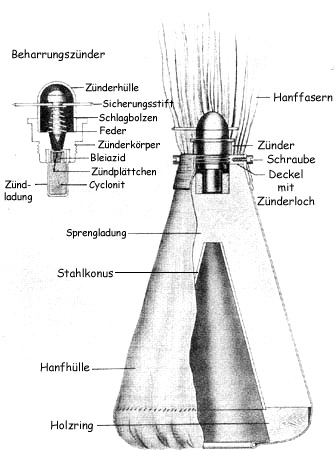
left:
fuze:
- upper fuze body
- safety pin
- striker
- creep spring
- lower fuze body
- Lead Azide
- primer
- gaine
- cyclonite
right:
- tail
- fuze
- screw
- adapter ring
- explosive charge
- cone
- cloth bag
- wooden base
There were only two versions, not three as mentioned at the inert-ord website. The third version is in fact version 2 with Picric Acid instead of Pentolite.
Version 1 had a steel cone , version 2 an aluminium cone.
Type 1 frangible chemical grenade:

In the 1930´s the japanese army developed various types of chemical agents. For the use of less toxic agents in the field a simple special grenade was developed.
a) frangible smoke grenade:
Data:
over-all length: 83,8 mm
maximum diameter: 66 mm
circumference: 236 mm
color: light yellow
total weight: 231 g
filling: Titanium and Silicon Tetrachloride
weight of filling: 98 g
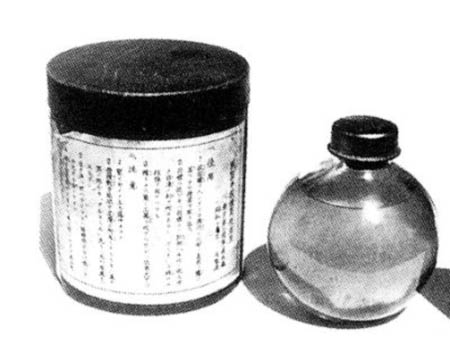
Description: This grenade is a flat bottomed sperical container made of clear glass. It has a short neck closed by a rubber stopper held under a red rubber washer within an inner iron crown cap. The filling is a mixture of Titanium and Silicon Tetrachloride which will be hydrolyzed by the moisture of the air, with the formation of Hydroxides and Hydrochloric Acid.
Operation:
The grenade is thrown and on impact the glass bottle breaks releasing the fluid and producing smoke. It is intended for use in screening operations. Though the filler is irritating to the skin as a liquid, in ordinary field concentrations the smoke is hardly irritating enough to cause coughing.
There was also a CS-type filling using a mixture of Chloracetophenone and Chlorpicrin.
b) frangible HCN-Grenade

Data:
maximum diameter: 99 mm
total weight: 545 g
filling: Hydrocyanic Acid
weight of filling: 290 g
maximum capacity: 346 g
Description:
These grenades are recognizable mainly as round glass bowls filled with HCN. They differ in minor details.
- The copper stabilized type is round bottomed whereas the 172 B-K and 172 C-K have flat bottoms.
- The copper gives one a yellow tint while the other two appear to be light green.
- The copper stabilized type has one moulded ring around the outside instead of two as the others have.
- The copper stabilized type is closed by a crown cap over a cork stopper and the other two are closed by a crown cap over a rubber washer.
- The copper stabilized type is carried in a sheet metal container and the 172 B-K and 172 C-K are carried in cardboard containers.
The grenades contain 290 g of liquid which is about 80% Hydrocyanic Acid. This is a very strong systemic poison.
Operation:
The grenade is thrown and on impact the glass will break releasing the HCN. This gas is swift and deadly if inhaled. In such quantities the gas is excetionally nonpersistent so these grenades are designed for use in small closed spaces such as pillboxes or tanks.
These grenades were used against british tanks in Burma.
Yours
tom!
Inteligency report from March 1945 in regard of this weapons:
Besides the Model 99 magnetic mine, which already has been used on a wide scale, two other hand-thrown antitank demolitions are known to have been developed and experimented with by the Japanese Army. They are the Conical Hand Mine and the Experimental Hand-thrown Mine.

The Model 3 Conical Hand Mine actually is an antitank bomb or hand grenade. This grenade has been found in captured ammunition dumps in the Philippines, although there have been no reported attempts by the enemy to use it. Of Japanese naval manufacture, it comes in two sizes—one weighing 2 pounds, and the larger weighing 3 pounds. Like the Lunge Mine, the Conical Hand Mine is a cone shaped, hollow charge designed to direct the force of explosion against tank armor. The large end of the grenade cone is covered by a bowl-shaped wooden base. The whole body of the grenade is encased in a silk bag sewn to fit tightly around the explosive unit and the wooden base.
The fuze, which functions on impact, is located in the narrow end of the bomb, and is designed to detonate regardless of the angle at which the grenade strikes the target. To ensure detonation, the grenade must be thrown with force. To be safe from the effect of the explosion, the soldier who throws the grenade must be at least 35 feet from the target. The grenade reputedly can penetrate 3/4 inch of armor.
Approximately 20 inches of hemp-palm fibers resembling a grass skirt are attached to the narrow end of the grenade, and serve as a tail or stabilizer when the grenade is thrown. This permits the grenade to strike base-first on the target.
The Experimental Hand-thrown Mine is a spherical bomb 4.7 inches in diameter. It is composed of 3 pounds of explosive encased in a black aluminum shell. Like the Conical Hand Mine, it is reported as capable of penetrating 3/4 inch armor, and must be thrown from a distance of at least 30 feet from the target. A carrying handle and a fuze cover are attached to the outside of the mine. During shipment the fuzes are packed separately, and must be inserted in the mine by unscrewing the fuze cover and inserting the fuze in the recess provided. The fuze is similar to that on the Conical Hand Mine, and is kept unarmed by a safety pin. Since the fuze will detonate the bomb upon impact with the target, the mine requires careful handling after the safety pin has been removed.
http://www.lonesentry.com/articles/jp_tankhunters/index.html
Sorry to come a bit late to this one :roll:
My information is that all Type 97 AT rifles were semi-auto. Some confusion may have been caused by the fact that a full-auto version (initially also known as the Type 97) was developed for aircraft use, and used in two variations: the Ho-1 (flexible) and the Ho-3 (fixed). These had much bigger magazines and fired at about 400 rpm. They saw very little use.
Reference was made to the ammo used: it is correct that some projectiles were shared between the 20x125 used in the Type 97 and the 20x142 used in the Type 98 AA gun. The pic below (from the ammo photo gallery on my website) shows the difference in size between the two cartridges. As you can see, they are both loaded with the same type of AP projectile.
Tony Williams: Military gun and ammunition website and discussion forum

The white-green band of those indicates API bullet I guess, rare color designation.
They had a great variaty of infantry AT weapons but which tanks did they actually encounter?
They had to fight agaist the M3 Stuart and the M4 Sherman this last one mostly belonging to the Marines.
Hi.
Enemy tanks:
China:
among others
- BA 20
- BA 10
- SdKfz 222
- SdKfz 223
- Panzer I
- Vickers 6t
- Vickers amphibious tank
- T-26
- Renault FT 17/18
- CV 33
- US Medium M4
- US Light M3
UK and Commonwealth:
among others
- Bren Carrier
- US Halftrack M3
- Light Mk VI
- Rolls Royce armoured car
- Valentine, also flamethrower variants
- Mathilda II, also flamethrower variants
- US Light M3
- US Medium M3 Lee
- GB Medium M3 Grant
- US Medium M4
USA:
among others
- US Halftrack M3 various variants
- US Light M2
- US Light M3
- US Light M5
- US Medium M3
- US Medium M4 various variants
- US Tank Hunter M10
- US Tank Hunter M18
- LVT various variants
Netherlands (KNIL):
among others
- ovaervalwagen
- Krupp APC
- Vickers 6t
- Vickers tankette
- GB Light Mk V and Mk VI
- Bren Carrier
Sovíet Union:
among others
- BA 5
- BA 6
- BA 20
- BA 64
- BT 2
- BT 5
- BT 7 various variants
- T-26 various variants
- T-38
- T-60
- T-70
- T-34 various variants
- IS 1
- IS 2
- IS 3
- SU-12
- SU-76
- SU-85
- SU-100
- SU-122
- ISU-122
- SU-152
- ISU 152
Yours
tom! 
Well, that is a list ¡
IS 1
- IS 2
- IS 3
Poor japanese panzerknackers, they have no a effective weapon against those.
